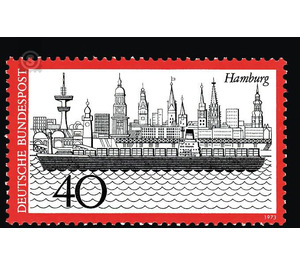tourism - Germany / Federal Republic of Germany 1973 - 40 Pfennig
Theme: Architecture
| Country | Germany / Federal Republic of Germany |
| Issue Date | 1973 |
| Face Value | 40.00 |
| Color | black grey red |
| Perforation | K 14 |
| Printing Type | Typography |
| Stamp Type | Postage stamp |
| Item Type | Stamp |
| Chronological Issue Number | 650 |
| Chronological Chapter | GER-BRD |
| SID | 736564 |
| In 60 Wishlists | |
For a long time tourism has not been an exclusive matter for seaside resorts, climatic resorts or mountain villages. Increasingly, the cities have learned to "put themselves in the right light" for the tourist as well and draw attention to their attractions and special opportunities - with success, as proven by the tourism statistics. Hamburg's attraction is based today, as in earlier times, above all on its port, whose romance and charm could not suppress the rapid technical development. In the Federal Republic of Germany, the Port of Hamburg still holds first place, and on the list of the largest European seaports it ranks at the top. After the extensive destruction in the Second World War, the reconstruction of its facilities and facilities after 1945 took place quickly and in a modern way. Significant annual investment has helped Hamburg - with the help of the latest transhipment techniques and transport systems - to maintain its reputation as a fast and efficient seaport. The container ship pictured on the Hamburg brand symbolizes Hamburg's successful efforts in this area. New transport routes for different modes of transport - such as the new motorway ready for use in 1974, which connects the port directly to the Scandinavian region via a new Elbtunnel, or the Elbeseitenkanal, a modern inland waterway that connects the Hamburg harbor to the European waterway network and will be completed in 1976 - will enable even faster goods transport and removal in the future. But Hamburg is not a port city, the North German metropolis has a harbor! And it is also the largest industrial city in the Federal Republic of Germany, international trade and service center and cultural center of the coastal region. Nevertheless, Hamburg has remained a city in the countryside, whose entertainment possibilities can meet all, and not only the demands and expectations of Reeperbahn dance. The International Horticultural Exhibition, which will unfold its flowerage in the spring of 1973, and the already known Congress Center Hamburg, which will open its doors at the same time to accommodate up to 11,000 people in its 15 halls, will set new accents. Rüdesheim am Rhein - the world-famous and wine-loving town at the gateway to the romantic Middle Rhine. His name indicates a foundation in Franconian times in the 6th or 7th century. In the Middle Ages, Rüdesheim was the seat of a defensive knight's family, whose castles and towers still give the townscape the character. It is safe to assume that even the Romans used the excellent situation for viniculture and planted vines. Today, the Rüdesheim vineyard facilities are among the greatest in the world. Closely related to viticulture are the wine trade, the brandy and sparkling wine industry in Rüdesheim. Rüdesheim - the county seat of the Rheingau - has become an international tourist destination. Around three million guests visit the city every year to spend some carefree hours. Over 55% of the guests come from abroad. Worth seeing are the Niederwald monument, to reach with a modern cabin cable car, the wine museum in the 1000-year Brömserburg, remains of the old town fortification and the old castles and historic old half-timbered houses. Despite the partial destruction in the last war, great importance was attached to the restoration of the old cityscape.


